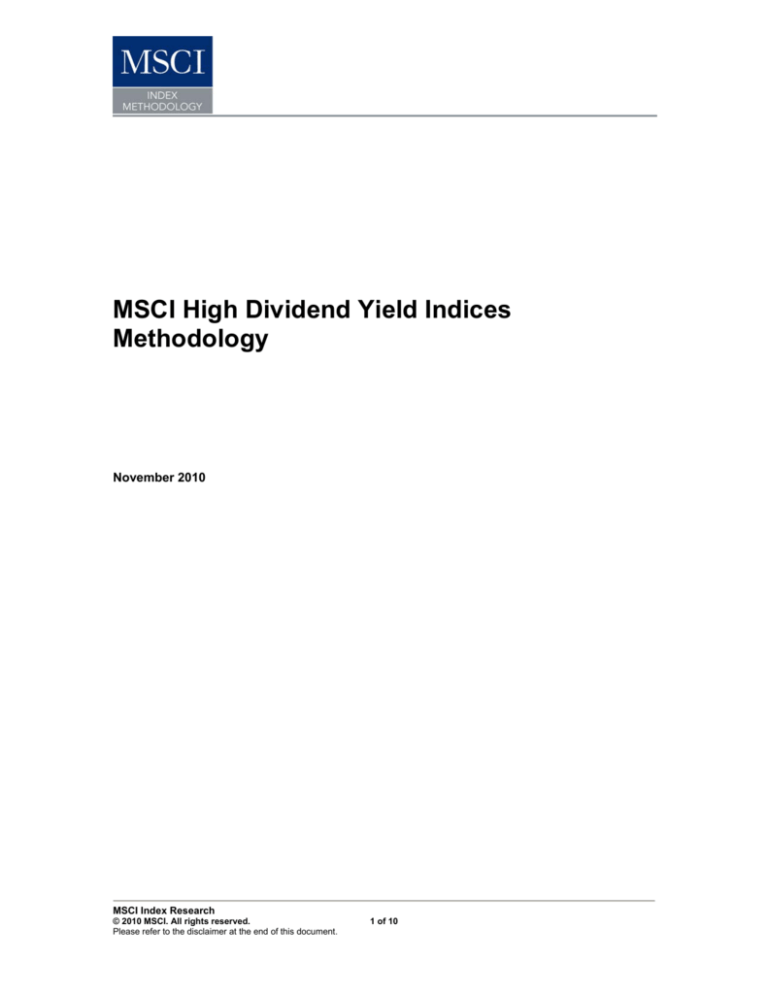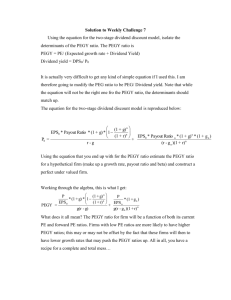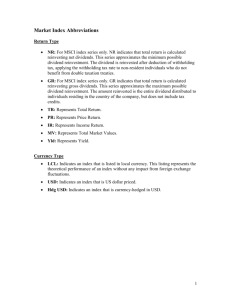
MSCI High Dividend Yield Indices
Methodology
November 2010
MSCI Index Research
© 2010 MSCI. All rights reserved.
Please refer to the disclaimer at the end of this document.
1 of 10
MSCI High Dividend Yield Indices
| November 2010
1. Introduction
MSCI has created the MSCI High Dividend Yield Indices to serve as a performance benchmark
for investors focusing on dividend yield and to help investors obtain and manage exposure to the
high dividend yielding segments of MSCI equity indices. The MSCI High Dividend Yield Indices
objectively and passively depict the high dividend yield opportunity set within MSCI equity indices
and are intended to reflect dividend yield focused investment processes.
The MSCI High Dividend Yield Indices:
•
Are derived from country, regional, or composite level MSCI Equity indices (herein, “Parent
Indices”).
•
Include only securities that offer a higher than average dividend yield relative to their respective
Parent Index and pass dividend sustainability screens
o
Securities entering the index must have a dividend yield which is at least 30% higher
than the respective Parent Index yield
o
Only securities with reasonable payout and a non-negative 5Y Dividends per share
(DPS) growth rate1 are eligible for inclusion in the High Dividend Yield Index.
•
Offer reasonably broad market coverage
•
Have moderate turnover due to the use of a market cap weighted scheme and appropriate
buffer rules and
•
Are free float market capitalization weighted to ensure that their performance can be replicated
in institutional and retail portfolios of reasonable size.
.
This Methodology book describes a generic methodology that can be applied to create MSCI High
Dividend Yield Indices from any of the existing MSCI global or domestic equity indices .The dividend
persistence screening (section 2.2.2) is currently not applied in Emerging Markets.
1
See appendix for definition of 5Y DPS growth rate and its calculation.
MSCI Index Research
© 2010 MSCI. All rights reserved.
Please refer to the disclaimer at the end of this document.
.
2 of 10
RV0710
MSCI High Dividend Yield Indices
| November 2010
2. MSCI High Dividend Yield Index Construction
The MSCI High Dividend Yield Index construction is based on a four -step process:
•
Defining the eligible universe
•
Applying dividend sustainability and persistence screening
•
Selecting high yielding securities
•
Weighting the securities in an index
MSCI High Dividend Yield Index Construction
Parent Index :
MSCI Standard or
Domestic
Dividend
Sustainability and
Persistence
Screens: Dividend
paying companies
with non-negative
dividend growth
rate and non
excessive payout
Eligible Universe:
MSCI Parent Index
ex REITs
Constituent
Selection:
Companies with
dividend yield
greater than or
equal to 1.3 times
the dividend yield of
the MSCI Parent
Index
2.1 Defining the Eligible Universe
All securities belonging to the underlying Parent Index are eligible for inclusion in the MSCI High
Dividend Yield Index, with the exception of Real Estate Investment Trusts (REITs). REITs have
structurally very high dividend yield and, if included, would represent a very significant proportion of the
MSCI High Dividend Yield Index. Also, typically, regulatory constraints restrict the inclusion of REITs in
meaningful proportions in many institutional portfolios.
MSCI Index Research
© 2010 MSCI. All rights reserved.
Please refer to the disclaimer at the end of this document.
.
3 of 10
RV0710
MSCI High Dividend Yield Indices
| November 2010
2.2 Dividend Sustainability and Persistence Screening
Dividend yield strategies typically target not only high dividend yield but also companies where
that dividend is sustainable and/or persistent. Therefore, MSCI High Dividend Yield Indices
consider the following dividend sustainability and persistence screens in order to achieve a better
representation of the opportunity set available to managers following high dividend yield
investment processes:
•
Dividend sustainability screening: Securities whose dividend payout is extremely high or
negative, and therefore, where future dividend payments might be in jeopardy are not
considered for inclusion
•
Dividend persistence screening: Securities without a good historical track record of
consistent dividend payment are also not considered for inclusion
2.2.1 Applying the Dividend Sustainability Screening
Securities with zero or negative payout ratios are not considered for inclusion in the MSCI High
Dividend Yield Indices as they either do not pay dividends or have negative earnings which may
put their future dividend payments at risk.
Additionally, securities with an extremely high payout ratio, which occurs when earnings are low
relative to dividends and may also indicate that the dividend payment might not be sustainable in
the future, are also not considered for inclusion in the MSCI High Dividend Yield Indices. Under
this screen, securities with extremely high payout ratios, defined to be the top 5% of securities by
number within the universe of securities with positive payout, are not considered eligible for
inclusion in the index. The use of a relative payout ratio screen ensures that the companies at
most relative risk of dividend cuts are excluded irrespective of the absolute level of the payout.
2.2.2 Applying the Dividend Persistence Screening
Securities with a negative 5Y DPS growth are also excluded from the index as their dividend
growth is shrinking which could be a precursor to lower dividends.
2.3 High Dividend Yield Security Selection
Securities that have passed the above two screens are then considered for inclusion in the High
Dividend Yield index. Only securities with a dividend yield greater than or equal to 1.3 times the
dividend yield of the Parent Index are included in the High Dividend Yield Index. For example,
MSCI compares the yield of a European security to the yield of the MSCI Europe Index to
determine if it is eligible for inclusion in the MSCI Europe High Dividend Yield Index. By contrast,
MSCI compares the yield of the same security to the yield of the MSCI World Index to determine
if it is eligible for inclusion in the MSCI World High Dividend Yield Index.
2.4 Free Float-Adjusting Constituent Weights
The MSCI High Dividend Yield Index is a free float adjusted market capitalization weighted index.
MSCI Index Research
© 2010 MSCI. All rights reserved.
Please refer to the disclaimer at the end of this document.
.
4 of 10
RV0710
MSCI High Dividend Yield Indices
| November 2010
3. Maintenance of the MSCI High Dividend Yield Indices
3.1 Semi-Annual Index Review
The MSCI High Dividend Yield Indices are rebalanced semi-annually. Changes are implemented
as of the close of the last business day of May and November, to coincide with the Semi-Annual
Index Reviews of their Parent Indices. The pro forma Indices are announced nine business days
before the effective date.
The fundamental data used to determine the High Dividend Yield Indices is maintained monthly.
For the May and November Semi-Annual Index Reviews, the fundamental data as of the end of
April and the end of October is used respectively.
The Semi-Annual Index Review involves a comprehensive review of the MSCI High Dividend
Yield Indices. During each Semi-Annual Index Review, the constituents of the underlying Parent
Index are screened for potential inclusion in the High Dividend Yield Index according to the
screening process described in Section 2.
Existing constituents of the current High Dividend Yield Index will also be evaluated for continued
inclusion using the following screening process:
•
If a security is already an Index constituent, it will remain in the index until it reaches the top
2% by increasing order of dividend payout. If it is within the top 2% limit, it will be excluded
from the Index.
•
If a security is already an Index constituent but its 5Y DPS growth rate turns negative, it will
still be allowed to remain in the Index, provided that the 1Y DPS growth rate2 of that security
is non-negative. This allows current Index constituents that suffer only a temporary decline in
the 5Y DPS growth rate to remain in the index and thus avoid excessive index turnover.
•
If a security is already an Index constituent, it will remain in the index as long as its dividend
yield is higher than or equal to the Parent Index yield.
3.2 Quarterly Index Reviews
The Quarterly Index Review of the Parent Indices will not result in any change in the MSCI High
Dividend Yield Indices except for deletions from the Parent Indices.
3.3 Ongoing event related changes
Between Semi-Annual Index Reviews, the MSCI High Dividend Yield Indices follow the event
maintenance of the Parent Index.
3.3.1 IPOs and other Early Inclusions
IPOs and other newly listed securities will only be considered for inclusion at the next semiannual index review, even if they qualify for early inclusion in the Parent Indices.
3.3.2 Additions and Deletions due to Corporate Events
There will be no early inclusion of new securities to the High Dividend Yield Index, except when
the new security results from an event affecting an existing constituent (e.g., spin off, merger).
A constituent deleted from the Parent Index following a corporate event will be simultaneously
deleted from the MSCI High Dividend Yield Index.
2
See appendix for definition of 1Y DPS growth and its calculation.
MSCI Index Research
© 2010 MSCI. All rights reserved.
Please refer to the disclaimer at the end of this document.
.
5 of 10
RV0710
MSCI High Dividend Yield Indices
| November 2010
Appendix I: Variable Definitions and Computations
This appendix provides details on the definitions and computations of the variables used to
screen the securities for index construction and maintenance.
1. Dividend yield (D / P)
D / P = Current Annualized Dividend per Share / Price of Security
The current annualized dividend per share is the trailing 12-month dividend per share derived
from the current fiscal year end dividend per share plus the difference between the interim
dividend per share of the current fiscal year and the previous fiscal year. For the USA and
Canada, the current annualized dividend per share is calculated by annualizing the latest
published quarterly dividend.
Yields are gross, before withholding tax, and take into account special tax credits when
applicable.
2. Payout Ratio (PO)
The payout ratio is calculated as follows:
PO = Dividends per share/ Earnings per share
The most recently reported earnings value is used to for earnings per share while the current
annualized dividend per share is used for dividends.
3. 5Y DPS Growth
For the calculation of the 5Y DPS Growth, first a regression (ordinary least squares method)
is applied to the last 5 yearly DPS.
DPSt = a×t + b
Where:
• a, the slope coefficient,
• b, the intercept,
• t, the year expressed in number of months.
Then, an average DPS is estimated:
n
~ ~ ~
DPS =
DPS
i
i =1
n
The growth trend is finally obtained as follows:
5Y DPS G =
aDPS
~ ~ ~
DPS
MSCI Index Research
© 2010 MSCI. All rights reserved.
Please refer to the disclaimer at the end of this document.
.
6 of 10
RV0710
MSCI High Dividend Yield Indices
| November 2010
In order to compute a meaningful long-term historical growth trend for the DPS, 5 years of
comparable data are generally required. In the event that comparable restated pro forma data
are unavailable, MSCI may restate the data using adjustments. A minimum of the last four
DPS values are required for calculating the growth and growth trends for securities without
sufficient DPS values are considered to be missing (except in the case of IPOs where it will
be on a case-by-case basis.).
4. 1Y DPS Growth
The 1Y DPS growth rate is the difference between the current and previous annual DPS.
1Y DPS G =
DPS t − DPS t − 12
DPS t − 12
Where:
• t is the year expressed in number of months.
The 1Y DPS growth is used for assessing the continued eligibility of existing constituents
whose 5Y DPS growth has turned negative.
MSCI Index Research
© 2010 MSCI. All rights reserved.
Please refer to the disclaimer at the end of this document.
.
7 of 10
RV0710
MSCI High Dividend Yield Indices
| November 2010
Appendix II: Calculation of Market Mean
This appendix explains the calculation of the market mean used in the determination of the
market average dividend yield.
The market mean is the market capitalization weighted average of the variable and is computed
as follows:
Where,
n=number of securities included in the calculation.
If any per share figure is not available for a particular security, the security is not included in the
calculation for that particular ratio.
Only securities with non-missing variables are included in the market mean and standard
deviation.
MSCI Index Research
© 2010 MSCI. All rights reserved.
Please refer to the disclaimer at the end of this document.
.
8 of 10
RV0710
MSCI High Dividend Yield Indices
| November 2010
Contact Information
clientservice@msci.com
Americas
Americas
1.888.588.4567 (toll free)
Atlanta
+ 1.404.551.3212
Boston
+ 1.617.532.0920
Chicago
+ 1.312.675.0545
Montreal
+ 1.514.847.7506
Monterrey
+ 52.81.1253.4020
New York
+ 1.212.804.3901
San Francisco
+ 1.415.836.8800
Sao Paulo
+ 55.11.3706.1360
Stamford
+1.203.325.5630
Toronto
+ 1.416.628.1007
Europe, Middle East & Africa
Amsterdam
+ 31.20.462.1382
Cape Town
+ 27.21.673.0100
Frankfurt
+ 49.69.133.859.00
Geneva
+ 41.22.817.9777
London
+ 44.20.7618.2222
Madrid
+ 34.91.700.7275
Milan
+ 39.02.5849.0415
Paris
0800.91.59.17 (toll free)
Zurich
+ 41.44.220.9300
Asia Pacific
China North
10800.852.1032 (toll free)
China South
10800.152.1032 (toll free)
Hong Kong
+ 852.2844.9333
Seoul
+827.0768.88984
Singapore
800.852.3749 (toll free)
Sydney
+ 61.2.9033.9333
Tokyo
+ 81.3.5226.8222
www.msci.com | www.riskmetrics.com
MSCI Index Research
© 2010 MSCI. All rights reserved.
Please refer to the disclaimer at the end of this document.
.
9 of 10
RV0710
MSCI High Dividend Yield Indices
| November 2010
Notice and Disclaimer
This document and all of the information contained in it, including without limitation all text, data, graphs, charts
(collectively, the “Information”) is the property of MSCl Inc., its subsidiaries (including without limitation Barra, Inc.
and the RiskMetrics Group, Inc.) and/or their subsidiaries (including without limitation the FEA and ISS, companies)
(alone or with one or more of them, “MSCI”), or their direct or indirect suppliers or any third party involved in the
making or compiling of the Information (collectively (including MSCI), the “MSCI Parties” or individually, an “MSCI
Party”), as applicable, and is provided for informational purposes only. The Information may not be reproduced or
redisseminated in whole or in part without prior written permission from the applicable MSCI Party.
The Information may not be used to verify or correct other data, to create indices, risk models or analytics, or in
connection with issuing, offering, sponsoring, managing or marketing any securities, portfolios, financial products or
other investment vehicles based on, linked to, tracking or otherwise derived from any MSCI products or data.
Historical data and analysis should not be taken as an indication or guarantee of any future performance, analysis,
forecast or prediction.
None of the Information constitutes an offer to sell (or a solicitation of an offer to buy), or a promotion or
recommendation of, any security, financial product or other investment vehicle or any trading strategy, and none of
the MSCI Parties endorses, approves or otherwise expresses any opinion regarding any issuer, securities, financial
products or instruments or trading strategies. None of the Information, MSCI indices, models or other products or
services is intended to constitute investment advice or a recommendation to make (or refrain from making) any kind
of investment decision and may not be relied on as such.
The user of the Information assumes the entire risk of any use it may make or permit to be made of the Information.
NONE OF THE MSCI PARTIES MAKES ANY EXPRESS OR IMPLIED WARRANTIES OR REPRESENTATIONS
WITH RESPECT TO THE INFORMATION (OR THE RESULTS TO BE OBTAINED BY THE USE THEREOF), AND
TO THE MAXIMUM EXTENT PERMITTED BY LAW, MSCI, ON ITS BEHALF AND ON THE BEHALF OF EACH
MSCI PARTY, HEREBY EXPRESSLY DISCLAIMS ALL IMPLIED WARRANTIES (INCLUDING, WITHOUT
LIMITATION, ANY IMPLIED WARRANTIES OF ORIGINALITY, ACCURACY, TIMELINESS, NON-INFRINGEMENT,
COMPLETENESS, MERCHANTABILITY AND FITNESS FOR A PARTICULAR PURPOSE) WITH RESPECT TO
ANY OF THE INFORMATION.
Without limiting any of the foregoing and to the maximum extent permitted by law, in no event shall any of the MSCI
Parties have any liability regarding any of the Information for any direct, indirect, special, punitive, consequential
(including lost profits) or any other damages even if notified of the possibility of such damages. The foregoing shall
not exclude or limit any liability that may not by applicable law be excluded or limited, including without limitation (as
applicable), any liability for death or personal injury to the extent that such injury results from the negligence or wilful
default of itself, its servants, agents or sub-contractors.
Any use of or access to products, services or information of MSCI requires a license from MSCI. MSCI, Barra,
RiskMetrics, ISS, CFRA, FEA, EAFE, Aegis, Cosmos, BarraOne, and all other MSCI product names are the
trademarks, registered trademarks, or service marks of MSCI in the United States and other jurisdictions. The
Global Industry Classification Standard (GICS) was developed by and is the exclusive property of MSCI and
Standard & Poor’s. “Global Industry Classification Standard (GICS)” is a service mark of MSCI and Standard &
Poor’s.
© 2010 MSCI. All rights reserved.
About MSCI
MSCI Inc. is a leading provider of investment decision support tools to investors globally, including asset managers,
banks, hedge funds and pension funds. MSCI products and services include indices, portfolio risk and performance
analytics, and governance tools.
The company’s flagship product offerings are: the MSCI indices which include over 120,000 daily indices covering more
than 70 countries; Barra portfolio risk and performance analytics covering global equity and fixed income markets;
RiskMetrics market and credit risk analytics; ISS governance research and outsourced proxy voting and reporting
services; FEA valuation models and risk management software for the energy and commodities markets; and CFRA
forensic accounting risk research, legal/regulatory risk assessment, and due-diligence. MSCI is headquartered in New
York, with research and commercial offices around the world.
MSCI Index Research
© 2010 MSCI. All rights reserved.
Please refer to the disclaimer at the end of this document.
.
10 of 10
RV0710






